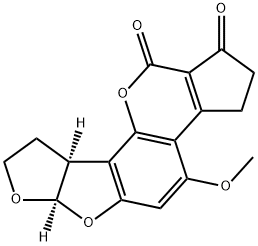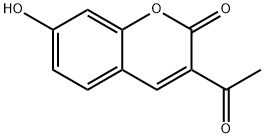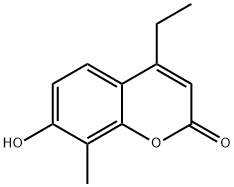AFLATOXIN B2
Synonym(s):Aflatoxin B2 solution
- CAS NO.:7220-81-7
- Empirical Formula: C17H14O6
- Molecular Weight: 314.29
- MDL number: MFCD00078140
- EINECS: 230-618-8
- SAFETY DATA SHEET (SDS)
- Update Date: 2025-01-27 09:38:02

What is AFLATOXIN B2?
Chemical properties
off-white powder
Chemical properties
The aflatoxins are a group of molds produced by the fungus Aspergillus flavus. They are natural contaminants of fruits, vegetables, and grains. They are also described as a series of condensed ring heterocyclic compounds. They form colorless to pale yellow crystals. Practically insoluble in water.
The Uses of AFLATOXIN B2
Aflatoxin B2 is the minor analogue of the blue fluorescent family of bisfuranocoumarin mycotoxins produced by Aspergillus flavus and related species. Alfatoxins are one of the most potent mycotoxins known but are in fact "pre-toxins", requiring metabolic activation to the toxic principle. Aflatoxins are found widely in nature in trace amounts, particularly in grains and nuts. The toxicity of these metabolites was first recognised in the 1950s and their structures elucidated in 1963. Aflatoxins have been extensively reviewed.
The Uses of AFLATOXIN B2
Aflatoxins B1, B2, G1, G2 as secondary metabolites of fungal species such as Aspergillus flavus or Aspergillus parasiticus growing on a variety of foods (peanuts, nuts, spices, cereals). Aflatoxins are a group of very carcinogenic mycotoxins with hepatotoxic effects.
The Uses of AFLATOXIN B2
Aflatoxins are naturally occuring mycotoxins produced by various species of the mold Aspergillus, which can be found in legumes, corn, soybeans, rice, milk, and cheese. They are highly carcinogenic substances that are metabolized by the liver to a reactive epoxide intermediate, which produces adducts that modify DNA. Aflatoxin B1 induces transversion of G to T at codon 249 of the p53 tumor suppressor gene. This transversion is common in hepatocellular carcinoma patients living in regions with high levels of aflatoxin contamination. Aflatoxin B2 is the dihydro derivative of aflatoxin B1, a naturally occuring mycotoxin and food contaminant that is a likely pathogen that causes hepatocellular carcinoma.[Cayman Chemical]
Definition
ChEBI: An aflatoxin having a hexahydrocyclopenta[c]furo[3',2':4,5]furo[2,3-h]chromene skeleton with oxygen functionality at positions 1, 4 and 11.
General Description
Aflatoxin B2 is one of the fungal metabolic products produced in food and feed, contaminated by?Aspergillus?species.
Safety Profile
Confirmed human carcinogen with experimental tumorigenic data. Poison by ingestion. Mutation data reported. When heated to decomposition it emits acrid smoke and fumes. See also various aflatoxins.
Potential Exposure
Aflatoxins are a group of toxic metabolites produced by certain types of fungi. Aflatoxins are not commercially manufactured; they are naturally occurring contaminants that are formed by fungi on food during conditions of high temperatures and high humidity. Most human exposure to aflatoxins occurs through ingestion of contaminated food. The estimated amount of aflatoxins that Americans consume daily is estimated to be 0.15 0.50 μg. Grains, peanuts, tree nuts, and cottonseed meal are among the more common foods on which these fungi grow. Meat, eggs, milk, and other edible products from animals that consume aflatoxincontaminated feed may also contain aflatoxins. Aflatoxins can also be breathed in
Shipping
UN3172 Toxins, extracted from living sources, solid or liquid, Hazard Class: 6.1; Labels: 6.1-Poisonous materials, Technical Name Required. UN2811 Toxic solids, organic, n.o.s., Hazard Class: 6.1; Labels: 6.1-Poisonous materials, Technical Name Required.
Incompatibilities
Incompatible with oxidizers (chlorates, nitrates, peroxides, permanganates, perchlorates, chlorine, bromine, fluorine, etc.); contact may cause fires or explosions. Keep away from alkaline materials, strong bases, strong acids, oxoacids, epoxides.
Waste Disposal
Consult with environmental regulatory agencies for guidance on acceptable disposal practices. Generators of waste containing this contaminant (≥100 kg/mo) must conform with EPA regulations governing storage, transportation, treatment, and waste disposal. Use of oxidizing agents, such as hydrogen peroxide or 5% sodium hypochlorite bleach. Acids and bases may also be used.
Properties of AFLATOXIN B2
| Melting point: | 286-289 °C |
| alpha | D -492° (c = 0.1 in CHCl3) |
| Boiling point: | 373.98°C (rough estimate) |
| Density | 1.2564 (rough estimate) |
| refractive index | 1.4800 (estimate) |
| Flash point: | 11 °C |
| storage temp. | 2-8°C |
| solubility | DMF: 20 mg/ml; DMF:PBS(pH 7.2)(1:1): 0.5 mg/ml; DMSO: 12 mg/ml |
| form | Solid |
| form | neat |
| color | White to off-white |
| Water Solubility | 15mg/L(temperature not stated) |
| Merck | 13,180 |
| BRN | 1355115 |
| CAS DataBase Reference | 7220-81-7 |
Safety information for AFLATOXIN B2
| Signal word | Danger |
| Pictogram(s) |
 Skull and Crossbones Acute Toxicity GHS06  Health Hazard GHS08 |
| GHS Hazard Statements |
H340:Germ cell mutagenicity H350:Carcinogenicity |
| Precautionary Statement Codes |
P201:Obtain special instructions before use. P262:Do not get in eyes, on skin, or on clothing. P280:Wear protective gloves/protective clothing/eye protection/face protection. |
Computed Descriptors for AFLATOXIN B2
New Products
1-Amino-1-cyclohexanecarboxylic acid Cycloleucine 6-Bromo-3-iodo-1-methyl-1H-indazole 3-(2,4-Dimethoxybenzyl)dihydropyrimidine-2,4(1H,3H)-dione 7-Bromo-1H-indazole ELECTROLYTIC IRON POWDER 2-Methyl-2-phenylpropyl acetate 1-Aminocyclobutanecarboxylic acid 1-(2-Ethoxyethyl)-2-(piperidin-4-yl)-1H-benzo[d]imidazole hydrochloride Decanonitrile tert-butyl 4-(1H-benzo[d]iMidazol-2-yl)piperidine-1-carboxylate 4-Ethylbenzylamine Methyl 5-bromo-2-chloro-3-nitrobenzoate N-(5-Amino-2-methylphenyl)acetamide 2-Chloro-3-nitropyridine 5-Bromo-2,3-dimethoxypyridine methyl 6-chloro-2-(chloromethyl)nicotinate 2-methoxy-4-methyl-5-nitro pyridine 2-iodo-5-bromo pyridine 2-amino-4-methyl-5-nitro pyridine 5-Fluoro-2-Oxindole methyl L-alaninate hydrochloride diethyl L-glutamate hydrochloride Ethyl tosylcarbamateRelated products of tetrahydrofuran





![AFLATOXIN B2, [8,9-3H]](https://img.chemicalbook.in/StructureFile/ChemBookStructure4/GIF/CB1332315.gif)
![7-Hydroxy-2,3-dihydro-1H-cyclopenta[c]chromen-4-one](https://img.chemicalbook.in/CAS/GIF/21260-41-3.gif)

You may like
-
 Aflatoxin B2 solution CAS 7220-81-7View Details
Aflatoxin B2 solution CAS 7220-81-7View Details
7220-81-7 -
 Aflatoxin B2 solution CAS 7220-81-7View Details
Aflatoxin B2 solution CAS 7220-81-7View Details
7220-81-7 -
 Aflatoxin B2 solution CAS 7220-81-7View Details
Aflatoxin B2 solution CAS 7220-81-7View Details
7220-81-7 -
 Aflatoxin B2 CAS 7220-81-7View Details
Aflatoxin B2 CAS 7220-81-7View Details
7220-81-7 -
 Diethyl Disulfide 99% HPLCView Details
Diethyl Disulfide 99% HPLCView Details
110-81-6 -
 6285-05-8. 1-(4-chlorophenyl) propan-1-one 98%View Details
6285-05-8. 1-(4-chlorophenyl) propan-1-one 98%View Details
6285-05-8. -
 4-chloro-3,5-dinitropyridine 98%View Details
4-chloro-3,5-dinitropyridine 98%View Details -
 171663-13-1 tert-Butyl 3-bromobenzylcarbamate 98%View Details
171663-13-1 tert-Butyl 3-bromobenzylcarbamate 98%View Details
171663-13-1